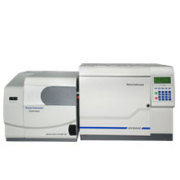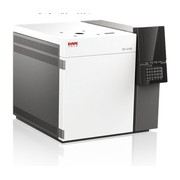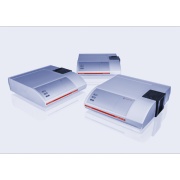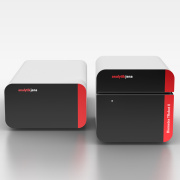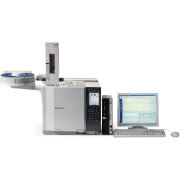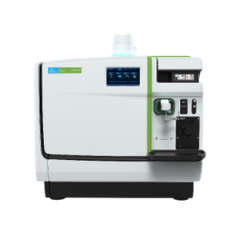Cathodoluminescence (CL)是透过电子轰击非金属材料产生的光放射,并通过高分辨的采集分光镜,得到阴极荧光影像及谱图,以深入研究光电子学和其他半导体材料学的精细成像仪器。CL是一种灵敏的成像和分析技术,为SEM (或TEM)提供许多重要科技材料的讯息, 例如,半导体、陶瓷和钻石的杂质,差排,缺陷和晶界的信息,CL 揭示了地质样品上成带 (Zonation) ,微裂痕和过成长现象。
MonoCL3+ 可提供附加数码式电子束控制系统,图像处理和高感度探测器。
XiCLone是MonoCL3+的选配件,通过利用高性能的CCD相机,支持平行光谱和光谱成像,强大的软件能够采集和快速处理全部的CL时实数据,包括光谱移动成像。
Cathodoluminescence (CL)
Gatan's MonoCL3 is a dedicated, turn-key cathodoluminescence (CL) system for high resolution imaging and spectroscopy suitable for all Scanning Electron Microscopes (SEMs), many microprobes and some Scanning TEMs. As the name suggests, it is a third generation product based on the principal of exceptional light collection and detection efficiency, but containing many new improvements, advanced options and software features ensuring ease of use.
The exceptional light collection and detection efficiency is achieved using a precision turned parabolloidal collecting mirror directly coupled to a chamber-m ounted, high performance monochromator.
(Above) Gatan's MonoCL3+ system installed on an SEM including a CF302
liquid helium cold stage
Easy yet accurate alignment leads to efficient coupling, and hence the use of narrow slits for high spectral resolution, and for work with weak CL signals. This fundamental design ensures that CL can be performed without excessive beam injection conditions. This opens the door to applications or microscopes where the beam current is limited, for example, high spatial resolution CL, cold FE SEM, insulating materials.
MonoCL3 is the core product for CL imaging and spectral analysis. The software runs within powerful Digital Micrograph environment.
With the MonoCL3 platform, a wide range of detectors, monochromator gratings and system optics can be selected to extend the wavelength range or tailor the maximum sensitivity to the desired spectral regime.
MonoCL3+ provides additional Digiscan™ (DigiScan) digital beam control and image processing together with a Peltier-cooled High Sensitivity PMT.
ParaCL is an option for MonoCL3(+) and provides fast, parallel spectral acquisition using a CCD camera. The CCD camera covers the spectral range 200-1100nm.
XiCLone is a more powerful option for MonoCL3(+). Parallel spectral acquisition and spectrum imaging complement the standard functionality of pan and monochromatic imaging and serial spectroscopy.
Collection and Transmission
• Retractable mirror (75mm in X direction) without altering vacuum status of microscope. FESEM compatible. (Special MEXT option of 165mm extended retraction for large chamber SEMs)
• Direct optical coupling through chamber-mounted monochromator and to CL detectors
• Mirror switch between panchromatic and monochromatic mode.
• LED sensor shows mirror retraction status.
• Fine Y and Z control.
• High transmission efficiency optics
Switchable mirrors allows the system to operate in panchromatic or monochromatic mode. In panchromatic mode, the light bypasses the monochromator and is directly coupled to the PMT or diode detectors. In monochromatic mode, there are two options depending on the serial / parallel configuration.
• Serial configuration: Spectral analysis is performed by serial spectral acquisition and monochromatic imaging.
• Parallel configuration: User has the additional choice of parallel analysis, including XiCLone for spectrum imaging.
• High collection efficiency, precision diamond turned parabolloidal aluminium mirror. ~75% of all light is collected
• Mirror is 10mm high, with focal point 1mm below mirror. Typical shortest working distance of ~11-12mm.
• 1mm aperture in mirror for electron beam.
• Minimum magnification with uniform panchromatic CL collection, ~x150.
• Mirror detachable for protection, exchange with other mirrors (see below), or high tilt stage movement.
• Earthed using braid strap.
Short Working Distance Mirror (SWD)
• High collection efficiency, precision diamond turned parabolloidal aluminium mirror. ~85% of all light is collected
• Mirror is 6.5mm high, with focal point 0.7mm below mirror. Typical shortest working distance of ~7.5mm
• 0.5mm aperture in mirror for electron beam
• Minimum magnification with uniform CL collection, ~x300
• Mirror detachable for protection, exchange with other mirrors (see below), or high tilt stage movement
• Earthed using braid strap
Multi-Signal Mirror (MSM)
The MSM is an additionally supplied, swap-out modified version of either the standard or SWD. The modification is configurable to a users requirements to allow detection of other signals, e.g. EDS detector.
Although less CL is collected, this option allows enhanced simultaneous SE imaging, BSED imaging and a wider field of view CL imaging. Simultaneous CL and X-ray sensing requires the EDS and CL detectors to be on ports approximately opposite one another.
Injection Optics
MINOPT. Injection optics option allows a collimated light beam, e.g. from a laser to illuminated the specimen in the same area as the CL is collected from. An additional filter housing provides the ability to reject this stimulation. The choice of injection wavelength and filtering and whether it is performed in tandem with CL differentiates between advanced CL injection studies, Photoluminescence and Raman spectrosco py using the same spectrometer and detectors.
MonoCL3 for TEM and UHV instruments
A special retraction mechanism can be used for TEM and UHV special configurations. Where space is retricted a minature version of the collection optics are employed.
TEM mirror (left) and standard mirror attached to light guide (right).
MFH Filter Housing Option
MFH provides an additional colour selection facility using a manually operated filter holder with four slots prior to the imaging detector. Wide or narrow band pass filters, or cut-off filters provide a useful enhancement to the efficient direct panchromatic imaging path. This complements the limited width bandpass functionality when the light is dispersed through the spectrometer. MFH offers flexibility using standard 1 inch (25mm) circular optical filters which can be inserted into the light path as required. MFH can be supplied with Red Green Blue (RGB) filters or with 7 x 80nm band pass filters (BPF) covering the visible regime.
Monochromator gratings
The monochromator contains up to two gratings, which are user selectable. Once aligned in the factory more gratings can easily be exchanged by the user.
The chart shows the response coefficient for gratings with different blaze wavelengths. The blaze wavelength is the peak wavelength in terms of grating performance. This also influences the suitable range.
The second characteristic of the grating is the ruling density which determines the dispersion. A high ruling density provides high dispersion and therefore high spectral resolution.
A low ruling density offers lower dispersion and hence a larger wavelength scan. A lower dispersion also gives a wider band pass for a given slit width, and this can help with monochromatic imaging from weak broad band luminescence.
Reference files showing different performance as a function of wavelength for gratings of different blaze wavelengths.
Partial list of available gratings. Please request more details if suitable grating is not apparent.
PA3 and MRU
• PA3 controls and provides power for grating tilt, chopper and reference wave sensing, PMTs, diodes, pre-amplifiers, interlocks.
PA3 amplifies, quantifies and reports in software the output from PMTs and diodes.
Manual Remote Unit, (MRU) is standard on all MonoCL3 systems.
• Provides hands on easy adjustment of HT, contrast and brightness
• Includes digital readout of HT
• Warning light for overload and reset button for PMT protection
The MRU makes imaging control of the detectors easier than software control.
CL imaging
DigiScanCL is the optimum CL imaging solution for MonoCL3. DigiScanCL is based on DigiScan II but with additional hardware and software specific to MonoCL3.
Standard DigiScanCL includes 2 x high bit depth analogue inputs and 1 x pulse input which can work in synchrony. 2 x analogue inputs can be used to record the CL and other microscope image signal. The pulse input provides a more quantitative imaging signal of the raw number of PMT counts from the PMT / PA3 pulse discriminator circuitry. This circuitry is only applicable for a smaller range of PMT High Tension settings and is intended to complement the analogue image.
DigiScan II provide ultimate scan control flexibility with a user choice of pixel dwell time, integration, pixel density, bit depth and scan rotation. DigiScan II can be calibrated with a kV specific image calibration table. DigiScanCL provides the backbone of spectrum imaging applications. DigiScanCL also provides an additional linescan routine where the (slow) RS232 PA3 reported signal can be plotted as a linescan across images.
For MonoCL3 system (where DigiScan is not supplied), the imaging signal is provided as a configurable analogue voltage to be sampled by the SEM AUX input or 3rd party beam control system. The image quality will therefore depend on the flexibility and specifications of the scan system and frame store. Digital images recorded with low bit depth may not contain sufficient dynamic range to show variations in weak and strongly luminescing areas in the same specimen. Furthermore some frame stores have limited signal integration or scanning speeds which will limit performance for some specimens or experiments. Users are requested to contact Gatan if uncertain over the applicability of their microscope scan system / frame store, or auxiliary input for CL imaging.
In-Line Spectral Calibration Lamp
The In-Line Spectral Calibration lamp is included with MonoCL3 system, and ParaCL upgrades. It produces sharp peaks at known wavelengths and provides a useful wavelength calibration check without venting the microscope chamber.
Example data from In-Line spectral calibration lamp recorded using high and low dispersion grating using 0.15mm slit widths. Many different data sets
can be overlaid and rescaled for comparison.
Photomultipliers
Each MonoCL system has at least one photomultiplier tube (PMT). The PMT is a fast and very light sensitive detector. Gatan supplies the PMT with its own dedicated, low noise fast pre-amplifier allowing sample navigation and signal optimisation at TV raster rate. The choice of PMT depends on the application, the main difference between PMTs being spectral response and sensitivity.
BLUE PMT
Standard detector. UV-visible, UV glass, multi-alkali photo cathode, 500U response ~185-850 nm, peak wavelength 420 nm, room temperature NEP~6.6x10-16
RED PMT
Available as alternative to BLUE standard detector.
Visible light operation, borosilicate glass, multi-alkali photo cathode, response 300-900 nm, peak wavelength 600nm, room temperature NEP~1.5x10-15
HSPMT: High sensitivity PMT
Available as optional alternative (included with MonoCL3+). Recommended for FE SEM (especially cold cathode) and high spatial, and spectral resolution work. Uses high quantum efficiency GaAs (Cs) photo cathode, synthetic silica tube, 650S response, ~160 - 930 nm, Peltier cooling to -35°C (expected using 15°C water supply), NEP<7x10-18
System includes fast, low noise, integral dynode chain, and pre-amplifier and is specially designed for low noise imaging applications. Intelligent Peltier power supply provides digital readout temperature, auto cut-out protection circuitry for Peltier unit with alarm warning when water supply fails. Auto shut off water connections.
MonoCL3 with new peltier cooled HSPMT unit with integral pre-amplifier, lower base temperature, and intelligent power supply unit.
(Water connections not shown)
ERPMT: Extended range PMT
Available as optional alternative to HSPMT but using same cooling unit. InGaAs photocathode, borosilicate glass tube, 851K response ~300 - 1040 nm, NEP~2x10-16
All Peltier cooled PMTs require water cooling.
IRPMT14: Infra Red PMT
Wide range PMT, borosilicate glass, response ~300 -1400 nm, LN2 cooled operation, dedicated protection mechanism, NEP~ 4x10-14
Available as additional or optional alternative.
IRPMT17: Infra Red PMT
Ultra wide range PMT, borosilicate glass, response ~300-1700 nm, LN2 cooled operation, dedicated protection mechanism, NEP~ 2x10-13. IRPMT17 has extended spectral response but higher background signal to IRPMT14.
Available as additional or optional alternative.
NEP refers to noise equivalent power, a measure of the noise performance of the detector at typical operating voltages. The smaller the number, the better the expected signal to noise ratio for a given signal strength.
First order approximations of the response functions for each different blaze grating and detector type are provided in the software. The accuracies of these response functions are not quantified.
More accurate system response files are provided for common detector / grating combinations covering the spectral range 300-1700nm. System response files take into account the effect monochromator optics, gratings and quantum efficiency of detectors.
FIRMCL: Solid State Infra Red CL detectors
A high sensitivity LN2 cooled photodiode is an alternative to the IRPMT. The IRMCL option includes a photodiode (e.g. InGaAs) mounted vertically in an optical switch. FIRMCL also includes an IR grating, an optical chopper, and a lock-in amplifier. A lock-in amplifier ensures excellent, bias drift free signal extraction of the modulated sign
Alternative IR detectors (e.g. InGaAs) for imaging and spectroscopy further into the Infra Red (e.g. to 1.9, 2.1 or 2.3microns) are also available on request. Such lower sensitivity detectors may not be suitable for narrow bandpass imaging.
Note, solid state detectors in LN2 dewars may require occasional pumping to high vacuum to maintain performance.
MonoCL3 Software: DigitalMicrograph™
MonoCL3 software is an integrated solution and is key to making the product easy to use, in collecting, analysing, archiving and presenting results.
It forms part of the Gatan Microscopy Suite (GMS™), and runs within the industry standard DigitalMicrographTM environment.
DigitalMicrograph forms the backbone of all software solutions from Gatan and can be installed on-line for computers connected to equipment and as off-line versions for post-processing and analysis on office PCs.
Software plug-ins for DigitalMicrograph are controlled by licence such that users are not confused by software routines not applicable to their installation.
MonoCL3 software is fully compatible with DigiScanCL, XiCLone and EDS spectrum imaging solutions, ChromaCL and SmartEBIC
.
Files saved in DigitalMicrograph format contain many experimental parameters, and can be viewed using a thumbnails when opening, or using explorer. Files can also be exported in a variety of display formats and spectra can be exported simply into spreadsheets.
In addition to the many tools available in the DigitalMicrograph environment, the software provides the following functionality laid out in a simple manner.
Spectral acquisition is acquired and displayed in eV. The user can process spectroscopy results including spectrum images into eV post acquisition.
Multiple Gaussian peak fitting can be applied to data in nm or eV mode giving accurate central peak fitting and FWHM data. This software provides limited functionality with a one single spectrum, and is more powerful when applied to spectrum images as then the fitting software can produce new maps of spectral shifts, FWHM data, and residual signals.
Example of multiple Gaussian curves fit to CL spectrum. This can be performed in nm or eV,
and for XiCLone systems the fit can then be applied to all points in the image.
Digital Micrograph provides user friendly and versatile display of spectroscopy results and exporting in a variety of formats. Multiple spectra can be overlaid and easily rescaled or offset for comparison.
技术参数:
| Monochromator Type | Czerny Turne |
| F number | F4.2 |
| Focal length | 300 mm |
| Dispersion | 1.8 x 1800 / ruling density, nm/mm |
| Grating size | 69 x 69 mm |
| Entrance, exit slits | 0-10 mm, micrometer adjustment |
| Scanning | Stepper motor |
| Min step size | Grating dependent, 0.1 for higher resolution |
| Spectral resolution | Grating dependent, see notes below |
| Selectable gratings | Choice of 2, 1 supplied as standard |
| Calibration | Automatic, software control |
| Scanning range | Zero order-1.2µm with 1200 l/mm grating Zero order-2.4µm with 600 l/mm grating |
相关产品



 仪器对比
仪器对比




 关注
关注
